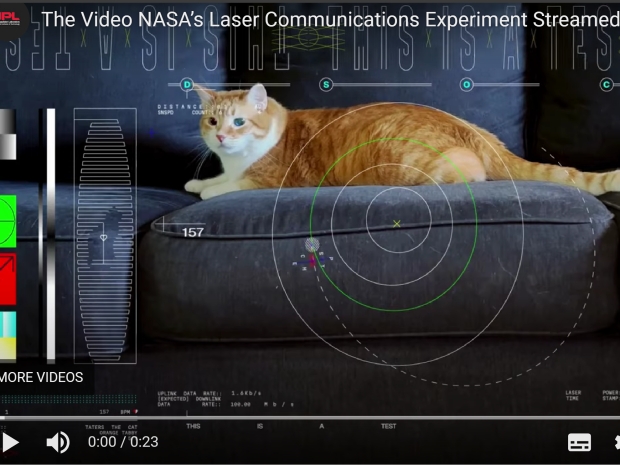The [15-second test] video signal took 101 seconds to reach Earth, sent at the system's maximum bit rate of 267 megabits per second (Mbps).
Uploaded before launch, the short ultra-high definition video features an orange tabby cat named Taters, the pet of a JPL employee, chasing a laser pointer, with overlayed graphics.
The graphics illustrate several features from the tech demo, such as Psyche's orbital path, Palomar's telescope dome, and technical information about the laser and its data bit rate. Tater's heart rate, color, and breed are also on display.
The network can send and receiving near-infrared signals to an encoded near-infrared laser to the Hale Telescope at Caltech's Palomar Observatory in San Diego County, California, where it is downloaded.
Each frame from the looping video was then sent "live" to NASA's Jet Propulsion Laboratory in Southern California, where the video was played in real time and LOLs were had by all.
The laser communications demo, which launched with NASA's Psyche mission on Oct. 13, is designed to transmit data from deep space at rates 10 to 100 times greater than the state-of-the-art radio frequency systems used by deep space missions today.
As Psyche travels to the main asteroid belt between Mars and Jupiter, the technology demonstration will send high-data-rate signals as far out as the Red Planet's greatest distance from Earth. In doing so, it paves the way for higher-data-rate communications capable of sending complex scientific information, high-definition imagery, and video in support of humanity's next giant leap: sending humans to Mars.
"Despite transmitting from millions of miles away, it was able to send the video faster than most broadband internet connections," said Ryan Rogalin, the project's receiver electronics lead at JPL. "In fact, after receiving the video at Palomar, it was sent to JPL over the internet, and that connection was slower than the signal coming from deep space. JPL's DesignLab did an amazing job helping us showcase this technology -- everyone loves Taters."


